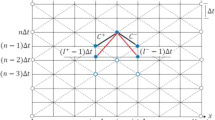We propose new formulas for calculating the friction factor in pipes with smooth walls and relations between the mean and the maximum fluid flow velocity in a pipe. The formulas are in better agreement with experimental data than the literature relations. An expression for the friction factor suitable for all flow conditions is proposed. The results of this work can be used in calculating the hydraulic resistance of pipes, as well as in calculating the heat and mass transfer processes in apparatuses incorporating tubular elements.
Similar content being viewed by others
References
E. Romeo, K. Royo, and A. Monzón, Improved explicit equations for estimation of friction factor in rough and smooth pipes, Chem. Eng. J., 86, No. 3, 369−374 (2002).
B. J. McKeon, M. V. Zagarola, and A. J. Smits, A new friction factor relationship for fully developed pipe flow, J. Fluid Mech., 538, 429−443 (2005).
A. Avci and I. Karagoz, A novel explicit equation for friction factor in smooth and rough pipes, J. Fluid Eng., 131, No. 6, 061203 (2009).
A. Ghanbari, F. F. Farshad, and H. H. Reice, Newly developed friction factor correlation for pipe flow and flow assurance, J. Chem. Eng. Mater. Sci., 2, 83−86 (2011).
X. Fang, Y. Xu, and Z. Zhou, New correlations of single-phase friction factor for turbulent pipe flow and evaluation of existing single-phase friction factor correlations, Nucl. Eng. Des., 241, 897−902 (2011).
B. J. McKeon, C. J. Swanson, M. V. Zagarola, R. J. Donnelly, and A. J. Smits, Friction factor for smooth pipe flow, J. Fluid Mech., 511, 41−44 (2004).
V. Gnielinski, New equations for heat and mass transfer in turbulent pipe and channel flow, Int. Chem. Eng., 16, 359−368 (1976).
I. O. Protod′yakonov and Yu. G. Chesnokov, Hydrodynamical Principles of the Processes of Chemical Technology [in Russian], Khimiya, Leningrad (1987).
Yu. G. Chesnokov, Infl uence of the Reynolds number on the laws of turbulent liquid flow in a plane channel, Zh. Tekh. Fiz., 80, 33−39 (2010).
Yu. G. Chesnokov, Calculation of some characteristics of turbulent fluid flow in a circular pipe, Zh. Prikl. Khim., 83, 1493−1498 (2010).
M. V. Zagarola and A. J. Smits, Mean-flow scaling of turbulent pipe flow, J. Fluid Mech., 373, 33−79 (1998).
B. J. McKeon, J. Li, W. Jiang, J. F. Morrison, and A. J. Smits, Further observation on the mean velocity distribution in fully developed pipe flow, J. Fluid Mech., 501, 135−147 (2004).
Yu. G. Chesnokov, Deviations from the temperature defect law, Zh. Prikl. Khim., 86, No. 2, 239−245 (2013).
N. Furuichi, Y. Terao, Y. Wada, and Y. Tsuji, Friction factor and mean velocity profile for pipe flow at high Reynolds numbers, Phys. Fluids, 27, 095108 (2015).
J. G. M. Eggels, F. Unger, M. H. Weiss, J. Westerweel, R. J. Adrian, R. Friedrich, and F. T. M. Nieuwstadt, Fully developed pipe flow: A comparison between direct numerical simulation and experiment, J. Fluid Mech., 268, 175−209 (1994).
K. Fukagata and N. Kasagi, Highly energy-conservative finite difference method for cylindrical coordinate system, J. Comput. Phys., 181, 478−498 (2002).
X. Wu and P. Moin, A direct numerical simulation study on mean velocity in turbulent pipe flow, J. Fluid Mech., 608, 81−112 (2008).
C. Chin, A. S. H. Ooi, I. Marusic, and H. M. Blackburn, The influence of pipe length on turbulence statistics computed from direct numerical simulation data, Phys. Fluids, 22, 115107 (2010).
G. K. El Khoury, P. Schlatter, A. Noorani, P. F. Fischer, G. Brethouwer, and A. V. Johansson, Direct numerical simulation of turbulent pipe flow at moderately high Reynolds numbers, Flow Turbul. Combust., 91, 475−495 (2013).
C. Chin, J. P. Monty, and A. Ooi, Reynolds number effects in DNS of pipe flow and comparison with channels and boundary layer, Int. J. Heat Fluid Flow, 45, 33−40 (2014).
Yu. G. Chesnokov, Deviations from the velocity defect law observed at low Reynolds numbers, Zh. Tekh. Fiz., 81, 30−34 (2011).
S. W. Churchill, Friction factor equations spans all fluid-flow regimes, Chem. Eng., 84, 91 (1977).
Author information
Authors and Affiliations
Corresponding author
Additional information
Translated from Inzhenerno-Fizicheskii Zhurnal, Vol. 90, No. 4, pp. 1005–1011, July–August, 2017.
Rights and permissions
About this article
Cite this article
Chesnokov, Y.G. New Formulas for Calculating the Fluid Flow Characteristics in a Circular Pipe. J Eng Phys Thermophy 90, 958–964 (2017). https://doi.org/10.1007/s10891-017-1643-5
Received:
Published:
Issue Date:
DOI: https://doi.org/10.1007/s10891-017-1643-5




